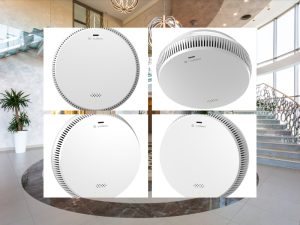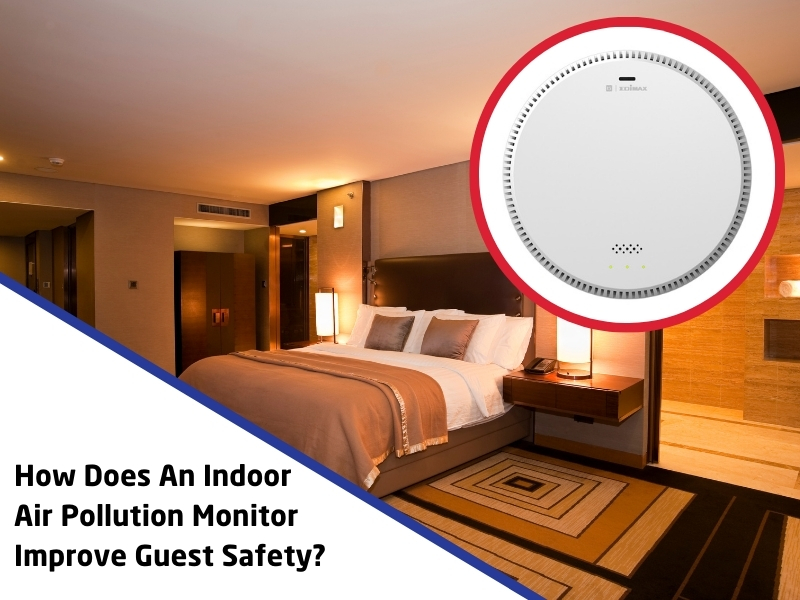Air quality plays a crucial role in health and well-being, especially in indoor environments where people spend most of their time. Poor indoor air quality can lead to respiratory problems, allergic reactions, and other health concerns. Businesses such as hotels, schools, hospitals, and offices must prioritise air quality to ensure guest safety. One effective way to achieve this is by using an indoor air pollution monitor, which helps detect harmful pollutants, track air quality trends, and enable timely interventions. This article explores the importance of air monitoring, key pollutants to watch for, and how businesses can implement effective solutions.
What is indoor air pollution, and why should businesses be concerned?
Indoor air pollution refers to harmful contaminants present in the air inside buildings. Unlike outdoor pollution, which is often regulated and monitored by government agencies, indoor air quality (IAQ) is frequently overlooked. Key concerns for businesses include:
- Health risks – Poor air quality can cause respiratory issues, headaches, fatigue, and worsen conditions like asthma.
- Guest comfort – Stale or contaminated air can lead to discomfort, affecting customer satisfaction and staff productivity.
- Regulatory compliance – Some industries have specific air quality requirements that businesses must meet to ensure compliance with health and safety laws.
- Legal and reputation risks – Neglecting air quality could lead to complaints, legal action, or reputational damage.
What are the key benefits of using an indoor air pollution monitor?
Indoor air pollution monitors provide essential data that help businesses maintain a healthy indoor environment. Key benefits include:
- Early detection of pollutants – Identifies harmful gases and particulates before they reach dangerous levels.
- Data-driven decision-making – Provides insights into air quality trends, enabling informed adjustments to ventilation systems.
- Energy efficiency – Optimises HVAC performance by ensuring air circulation is adjusted based on real-time needs.
- Compliance with safety standards – Ensures businesses meet workplace health and safety regulations related to air quality.
- Improved health and safety – Helps businesses take action to reduce exposure to allergens, smoke, or chemical fumes.

Understanding the benefits of clean air for hotel guests is crucial, as fresh, pollutant-free air enhances comfort, reduces allergy risks, and creates a healthier, more enjoyable stay.
Which pollutants can a high-quality air monitor detect?
A good indoor air pollution monitor should detect various pollutants that impact health and well-being. Common indoor pollutants include:
- Carbon Dioxide (CO2) – High levels indicate poor ventilation and can lead to drowsiness or reduced cognitive function.
- Volatile Organic Compounds (VOCs) – Chemicals released from paints, cleaning products, and furniture.
- Carbon Monoxide (CO) – A dangerous gas that can cause poisoning if levels become too high.
- Formaldehyde – Found in construction materials and household products.
- Mould Spores – Can trigger allergies and respiratory conditions.
- Tobacco and Vape Smoke – Harmful chemicals from smoking or vaping indoors.
- Particulate Matter (PM2.5 and PM10) – Fine particles from dust, smoke, and industrial emissions.
Exposure to airborne pollutants can be harmful, and understanding the health effects of particulate matter is essential.
What are the benefits of real-time alerts and remote monitoring?
Real-time air quality monitoring enables businesses to take immediate action when pollution levels rise. Key benefits include:
- Instant notifications – Alerts businesses when pollutants exceed safe levels.
- Remote access – Monitor air quality from anywhere via a mobile app or cloud platform.
- Automated responses – Can trigger HVAC adjustments, air purifiers, or alarms when needed.
- Data logging and reports – Helps track trends and improve air quality strategies over time.
- Enhanced guest confidence – Transparency about air quality can reassure customers and staff.
How can an air quality monitor integrate with existing ventilation and HVAC systems?
Integration with existing systems enhances efficiency and ensures optimal air quality management.
- Smart HVAC adjustments – Air quality data can trigger automatic ventilation adjustments.
- Reduced energy waste – Ensures HVAC runs only when needed, lowering costs.
- Automated filtration control – Activates air purifiers when pollution spikes.
- Seamless system compatibility – Many monitors work with existing building management systems.
- Compliance with regulations – Helps businesses meet industry-specific air quality standards.
What should you look for when choosing an indoor air quality monitor?
Selecting the right monitor is essential for effective air quality management.
Key features to consider:
- Multi-pollutant detection – Should monitor a wide range of pollutants.
- Real-time alerts – Immediate notifications when air quality deteriorates.
- Remote monitoring – Cloud-based access for convenient tracking.
- Data storage and reports – Historical data for long-term air quality analysis.
- Easy integration – Compatible with smart home or building systems.

Final thoughts: Prioritising guest safety with air quality monitoring
Maintaining excellent indoor air quality is crucial for businesses that prioritise guest safety and comfort. By investing in an indoor air pollution monitor, businesses can proactively detect and mitigate harmful pollutants, ensuring a healthier environment.
The Edimax 10-in-1 Air Quality Detector offers real-time monitoring, remote access, and seamless HVAC integration, making it a top choice for businesses aiming to improve air quality.
Take the next step in protecting your guests and staff. Contact Edimax for air quality solutions and create a cleaner, safer indoor space.
FAQs about indoor air pollution monitors
- How often should an indoor air pollution monitor be calibrated?
Most monitors require calibration every 6–12 months for accuracy.
- Can an air quality monitor detect mould?
It can detect conditions like humidity and VOCs that indicate mould growth.
- Is an air pollution monitor suitable for small businesses?
Yes, it’s beneficial for all businesses, from offices to cafés.
- Do air quality monitors work in large spaces?
Yes, but larger areas may require multiple units for full coverage.
- Can an air pollution monitor help reduce energy costs?
Yes, by optimising HVAC use based on real-time air quality data.
- Does an air quality monitor require Wi-Fi?
Some models need Wi-Fi for remote access, but others work offline.
- Are there government regulations on indoor air quality?
Yes, many industries must comply with air quality standards.
- Can an air quality monitor help with allergies?
Absolutely, by identifying allergens like dust and pollen.
- Is installation complicated?
No, most monitors are easy to install and integrate with HVAC systems.
- Do air quality monitors need regular maintenance?
Minimal maintenance is required, mainly occasional sensor cleaning.
